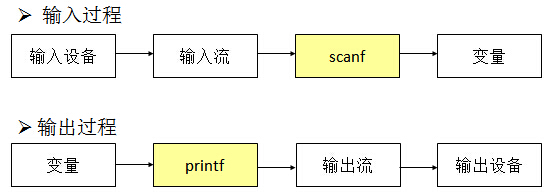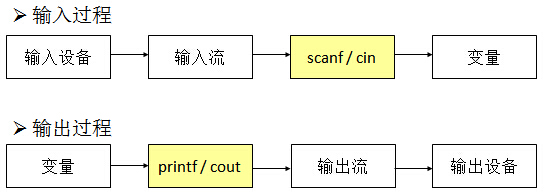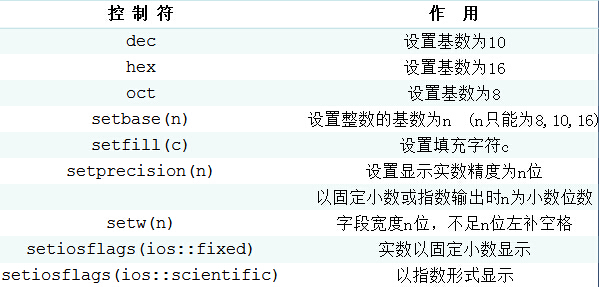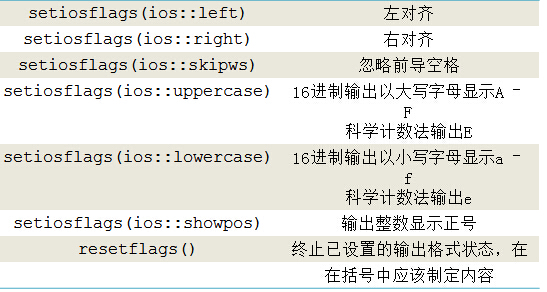int x = 1024;
C++提供兩種初始化方法:復制初始化(copy-initialization)
如:int x = 1024;
直接初始化(direct-initialization):
如:int x(1024);
注意:
①初始化不是簡單地賦值,初始化指聲明變量或對象並且賦初值;賦值指用新值覆蓋變量或對象當前值。
②直接初始化語法更靈活且效率更高
③初始化內置類型變量兩種初始化幾乎沒有差別對於類類型的初始化,有時只能采用直接初始化(以後討論)
④兩種初始化的方法可以混用(見下例)
合使用初始化的例子:
#include <iostream>
using namespace std;
int main()
{
double salary = 9999.99, wage(salary + 0.01);
cout<<salary<<" "<<wage<<endl;
int interval,month = 8, day = 7, year(2008);
cout<<year<<":"<<month<<":"<<day<<":"<<endl;
system("PAUSE");
return 0;
}
C語言的輸入輸出:

C++語言的輸入輸出:

C++語言的輸入輸出:先睹為快
#include <iostream>
using namespace std;
int main()
{
int x;
double y;
/*以下語句等價於printf("請輸入兩個整數(用逗號隔開):");*/
cout << "請輸入兩個整數(用空格隔開):";
/*以下語句等價於scanf("%d %f", &x, &y);*/
cin >> x >> y;
/*以下語句等價於printf("x = %d, y = %f\n", x, y);*/
cout << "x = " << x << ", y = " << y << endl;
system("PAUSE");
return 0;
}
C++的輸入輸出:cin,cout的用法
基本用法:cout<<表達式1<<表達式2<<表達式n;
cin>>變量1>>變量2>>變量n;
例如:cout<<"x + y ="<< x + y << "." << endl; cin >> x >> y;
[注意]
①不能用一個<<輸出多個數據項
cout<<a,b,c<<endl; /*錯誤*/ cout<<a<<b<<c<<endl; /*正確*/
②cin/cout可以分成多行來寫
cin>>a>>b
>>c;
cout<<a<<b
<<c;
cout的用法舉例:
#include <iostream>
using namespace std;
int main()
{
cout << "This is a C++ program! " << endl;
cout << "This is"
<< " a C++"
<< "program!"
<< endl;
system("PAUSE");
return 0;
}
cin的用法舉例:
int main()
{
char c1, c2;
int a;
float b;
cin >> c1 >> c2 >> a >> b;
cout << "c1 = " << c1 << endl
<< "c2 = " << c2 << endl
<< "a = " <<a << endl
<< "b = " << b << endl;
system("PAUSE");
return 0;
}
cout與輸出控制字符:
#include <iostream>
#include <iomanip>
using namespace std;
int main()
{
int x = 0;
cout << "請輸入一個八進制整數(以開始):";
cin >> oct >> x;
cout << "x的十六進制表示為:" << hex << x << endl;
cout << "x的十進制表示為:" << dec << x << endl;
cout << "x的八進制表示為:" << oct << x << endl;
system("PAUSE");
return 0;
}
輸出控制符:


注意:若用控制符,程序需包含頭文件#include<iomanip>
有關類型的區別:bool類型
邏輯類型
真
假
C
沒提供
非0
0
C++
bool
true
false
注意:
1)bool類型的取值只有兩種true,false
2)輸出時默認輸出0或者1
3)用boolalpha可以改變默認的輸出方式,noboolalpha可以恢復默認的輸出方式
#include <iostream>
using namespace std;
int main()
{
bool bval1 = 1 < 2;
bool bval2 = true;
bool bval3 = false;
bool bval4 = 4;
bool bval5 = 0;
cout << "bval1=" << bval1 << endl;
cout << "boolalpha bval1=" << boolalpha << bval1 << endl;
cout << "noboolalpha bval1=" << noboolalpha << bval1 << endl;
cout << "bval2=" << bval2 << endl;
cout << "bval3=" << bval3 << endl;
cout << "bval4=" << bval4 << endl;
cout << "bval5=" << bval5 << endl;
system("PAUSE");
return 0;
}
有關類型的區別:string類
#include <iostream>
#include <string>
using namespace std;
int main()
{
string name = "student";
string address = "Hebei... ...";
cout << name << address <<endl;
return 0;
}
string對象的定義和初始化:
初始化string對象的方式
string s1;
默認構造函數,s1為空串
string s2(s1);
將s2初始化為s1的一個副本
string s3("value");
用字符串字面值初始化s3
String s4(n,'c')
將s4初始化為字符'c'的n個副本
#include <iostream>
#include <string>
using namespace std;
string s0;
int main( )
{
string s1;
//string s2 = "hello world!";
string s2("hello world!");
//string s3 = s2;
string s3(s2);
string s4(5, 'r');
cout << "s0=" <<s0 <<endl;
cout << "s1=" <<s1 <<endl;
cout << "s2=" <<s2 <<endl;
cout << "s3=" <<s3 <<endl;
cout << "s4=" <<s4 <<endl;
system("PAUSE");
return 0;
}
string對象的讀寫:用cin、cout讀寫string對象
注意:
cin忽略開頭所有空格、TAB、回車符
不接收含空格的字符串
string的I/O:
#include <iostream>
#include <string>
using namespace std;
int main()
{
string s;
cin >> s; //hello world!
cout << s <<endl; //hello
system("PAUSE");
return 0;
}
string讀入未知數目的對象:
#include <iostream>
#include <string>
using namespace std;
int main()
{
string word;
while(cin >> word)
cout << word << endl;
system("PAUSE");
return 0;
}
string對象的讀寫:用getline讀取整行文本(含空格)。
#include <iostream>
#include <string>
using namespace std;
int main()
{
string line;
while(getline(cin, line))
cout << line << endl;
system("PAUSE");
return 0;
}
注意:
getline的第一個參數通常為cin, 第二個參數為string對象
從錄入數據的下一行讀取,可讀取 任何字符
getline()以回車作為結束符 (不接受換行符)
getline()不忽略前導回車,若第一 個就是換行符,則置為空串
string對象的操作,設有:string s, s1;string的操作
s.empty()
若s為空串,則返回true,否則返回false
s.size()
返回s中字符的個數
s[n]
返回s中位置為n的字符,位置從0開始
s1+s2
將兩個串連接成新串,返回新生成的串
s1 = s2
把s1得內容替換為s2的副本
v1 == v2
判定時候相等,相等返回true,否則返回false
!= < <= > >=
保持這些操作慣有的含義,如:s != s2;
注意:
1、size()的返回類型並非int而是string::size_type類型的值,建議不要把size()的返回值賦值給int變量
string s2 = "hello"; string::size_type count = s2.size();2、兩個string對象+時,+操作符左右操作數必須至少有一個是string
#include <iostream>
#include <string>
using namespace std;
int main()
{
string s1 = "hello";
string s2 = "world";
string s3 = s1 + ",";
string s4 = "hello" + "world "; //error
string s5 = "hello" + s2 + "world" ;
system("PAUSE");
return 0;
}
3、string對象下標操作時,任何無符號整型值均可用作下標,但下標的實際類型為string::size_type4、string下標操作可用作左值
int main()
{
string str = "student";
cout << str << endl;
for(string::size_type ix = 0; ix!=str.size(); ++ix)
str[ix] = 'x';
cout << str << endl;
system(" PAUSE ");
return 0;
}
有關類型的區別:枚舉
C++對枚舉的改進:
①在C++中定義枚舉變量可以不用enum
enum weekday
{sun, mon, tue, wed, thu, fri, sat};
weekday w; //省略了enum
②無名枚舉:不給出枚舉類型名和變量,將枚舉元素當符號常量用
enum
{min = 0, max = 100};
int x = min, arr[max];
... ...
有關類型的區別:union
C++對聯合的擴展:
①無名聯合:沒有聯合體類型名和變量名的聯合體
#include <iostream>
using namespace std;
int main()
{
union {
char c;
int i;
double d;
};
c = 'a';
cout << c << endl;
return 0;
}
②定義聯合變量無需給出union
#include <iostream>
using namespace std;
union test
{
char c;
int i;
double d;
};
int main()
{
test m = {'a'};
cout << m.c << endl;
return 0;
}
有關類型的區別:struct
C++對結構體的擴展
①定義結構體變量可以不用struct
struct point
{
double x;
int a;
};
point p;
②成員可以包含函數定義
struct point{
double x,y; //數據成員
void setvalue(double a,double b) //成員函數
{
x = a;
y = b;
}
};